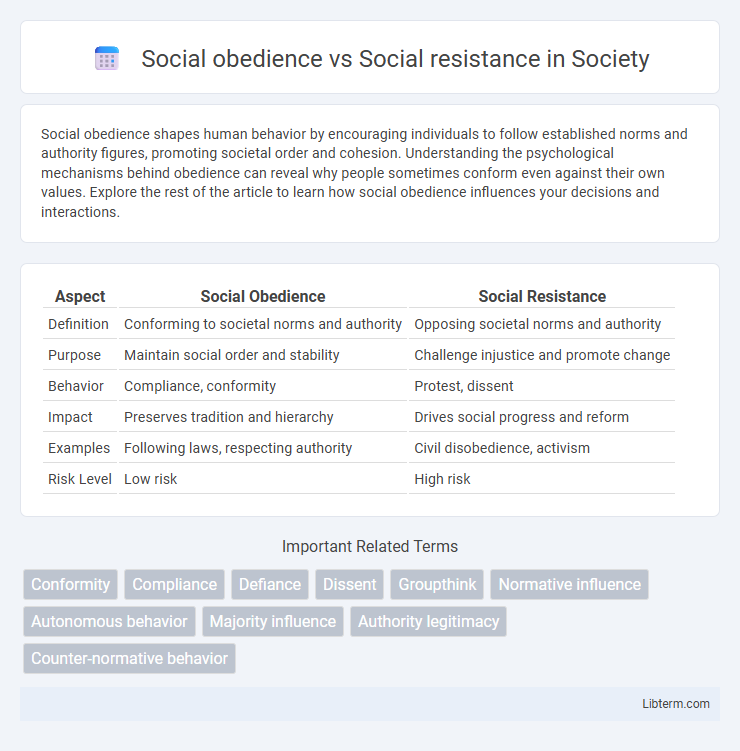Social obedience shapes human behavior by encouraging individuals to follow established norms and authority figures, promoting societal order and cohesion. Understanding the psychological mechanisms behind obedience can reveal why people sometimes conform even against their own values. Explore the rest of the article to learn how social obedience influences your decisions and interactions.
Table of Comparison
| Aspect | Social Obedience | Social Resistance |
|---|---|---|
| Definition | Conforming to societal norms and authority | Opposing societal norms and authority |
| Purpose | Maintain social order and stability | Challenge injustice and promote change |
| Behavior | Compliance, conformity | Protest, dissent |
| Impact | Preserves tradition and hierarchy | Drives social progress and reform |
| Examples | Following laws, respecting authority | Civil disobedience, activism |
| Risk Level | Low risk | High risk |
Defining Social Obedience and Social Resistance
Social obedience refers to the compliance with rules, norms, or authority figures within a society, facilitating order and cohesion. Social resistance involves the deliberate opposition or challenge against established norms, policies, or authorities to provoke change or highlight injustice. Understanding social obedience and resistance is critical for analyzing dynamics of power, conformity, and social change in communities.
Historical Contexts of Obedience and Resistance
Historical contexts of social obedience reveal patterns in which authoritative regimes, such as Nazi Germany and Stalinist Soviet Union, enforced conformity through propaganda and brutal repression to maintain control. In contrast, social resistance movements, including the Civil Rights Movement in the United States and anti-colonial struggles in India, demonstrate collective defiance against oppressive systems by mobilizing grassroots activism and civil disobedience. These examples highlight the dynamic interplay between state-driven obedience mechanisms and popular efforts to challenge and transform sociopolitical orders.
Key Psychological Theories Explaining Obedience
Key psychological theories explaining social obedience emphasize the role of authority and situational factors in compliance, as demonstrated by Milgram's obedience experiments highlighting the power of perceived authority figures. Social learning theory also contributes by showing how individuals internalize societal norms and behaviors through observation and reinforcement. Conversely, resistance to social pressure is often explained by theories of moral reasoning and cognitive dissonance, where individuals challenge authority based on personal values and conflicting beliefs.
Factors Influencing Social Resistance
Social resistance is influenced by factors such as individual values, cultural norms, and perceived legitimacy of authority. Strong social identity and group cohesion often bolster resistance movements by fostering solidarity and shared purpose. Access to information and communication channels also plays a critical role in enabling collective action against dominant social pressures.
The Role of Authority in Shaping Behavior
Authority plays a pivotal role in shaping behavior by dictating social obedience through established norms, rules, and enforcement mechanisms. Compliance often arises from perceived legitimacy and the desire to maintain social order, while resistance emerges when individuals or groups challenge authority due to perceived injustice or conflicting values. Psychological studies, like Milgram's experiments, demonstrate how authority figures can significantly influence individuals to act against personal morals, highlighting the complex dynamics between social obedience and resistance.
Societal Consequences of Conformity
Social obedience often leads to stability and order within societies by promoting adherence to laws and social norms, yet it can suppress individual freedoms and perpetuate unjust systems. Social resistance, in contrast, challenges established power structures and can drive social progress, but may also result in conflict and societal division. The balance between conformity and resistance shapes societal evolution, influencing governance, cultural norms, and collective behavior.
Case Studies: Famous Acts of Resistance
Case studies of social resistance such as the Montgomery Bus Boycott and the Tiananmen Square protests highlight the power of collective action against systemic oppression. These acts of resistance reveal how organized social movements challenge obedience norms imposed by authoritarian regimes or unjust policies. Analysis of these events demonstrates the role of leadership, solidarity, and strategic noncompliance in shifting public attitudes and prompting legislative or social change.
Modern Examples of Social Obedience
Modern examples of social obedience include compliance with government mandates during public health crises, such as mask-wearing and vaccination campaigns during the COVID-19 pandemic. Social obedience is also evident in workplace environments where employees adhere to organizational policies and hierarchy to maintain order and productivity. Digital platforms further illustrate obedience as users follow community guidelines and legal regulations to access services and avoid penalties.
Cultural Differences in Obedience and Resistance
Cultural differences significantly shape social obedience and resistance, with collectivist societies often emphasizing conformity and respect for authority, promoting higher obedience levels. In contrast, individualistic cultures typically encourage personal autonomy and questioning authority, fostering greater social resistance. Variations in social norms, values, and power distance influence how groups respond to social control and challenges to established hierarchies.
Balancing Obedience and Resistance in Society
Balancing social obedience and resistance is crucial for maintaining order while fostering progress within society. Obedience ensures stable adherence to laws and social norms, promoting cohesion and safety, whereas resistance challenges unjust systems and drives social change. Achieving equilibrium involves encouraging critical thinking and civic engagement, allowing individuals to discern when to comply and when to conscientiously oppose authority for ethical and democratic advancement.
Social obedience Infographic

 libterm.com
libterm.com